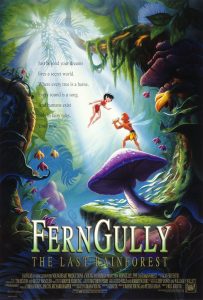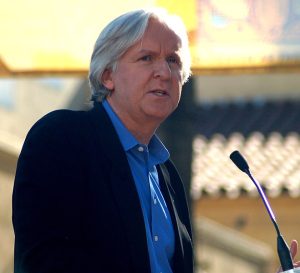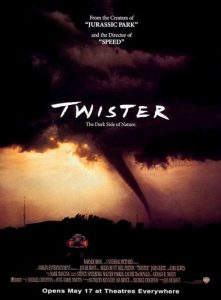4 Humans (bad) vs. Aliens/Nature/Indigenous Populations (good)

is licensed under CC BY-NC-SA 2.0.
It seems fitting to begin this exploration of Cli-Fi films with FernGully: The Last Rainforest (1992). Suitable for nearly all ages, this animated feature can introduce environmental issues to young viewers through a story focused on fairies and appealing, often goofy and humorous creatures populating a vividly colorful Australian rainforest. There, Crysta (Samantha Mathis) and her fellow fairies, including her mentor Magi and friend Pips, have never seen a human before, and in fact believe that they are extinct. But when a logging company arrives to destroy the rainforest, she sees that they do exist, accidentally shrinking a young logger named Zak (Jonathan Ward) whom she encounters. As Crysta befriends him, and through their adventures in FernGully – including encounters with Batty Koda (Robin Williams, in a role created for him), a bat who claims to have been experimented on by humans – Zak sees the damage that humans can do and helps Crysta to stop not only the loggers, but also a dark spirit named Hexxus (Tim Curry), who feeds off pollution. Hope literally springs eternal as Crystal gives Zak a seed, begging him to remember everything that has transpired as she restores him to his human size. Zak promises to remember his adventure in FernGully and buries the seed in the soil before telling his fellow departing loggers that things need to change. The seed sprouts new growth as Crysta playfully chases her fairy friend Pips, with Batty following.
FernGully now seems a bit dated, and its animation – a combination of hand-drawn and computer-generated – may fail to hold up under scrutiny from the Pixar generation. Janet Maslin of The New York Times criticized the film’s “Saturday-morning cartoon aesthetics.”[1] But it was in many ways a groundbreaking rated-G film at the time, with its focus on the environment. Producer Wayne Young said his passion for the subject was his motivation for making the film, saying the film was “blatantly environmental, although we have gone to a lot of trouble to avoid preaching. We also want it to be viewed as entertainment.”[2] Young reportedly donated portions of the products to Greenpeace, the Rainforest Foundation Fund, and the Sierra Club.[3] Although its box office receipts were far outmatched at the time by those for Disney films like The Little Mermaid (1989) and Beauty and the Beast (1991), it received generally favorable reviews, and audiences surveyed by CinemaScore gave the film a grade “A” on scale of A to F.[4] And it is impossible to know how many aspiring ecologists, environmentalists, and climate change scientists and advocates may have been inspired by FernGully: The Last Rainforest. It also may have influenced future Cli-Fi Films, such as Avatar.

licensed under CC BY-NC 2.0.
But it was certainly not the last animated film to highlight ecological issues and climate change. Five years later, Princess Mononoke (1997) harnessed anime, specifically, to address these, but this time set in a fantastical version of Medieval Japan. While perhaps not explicitly about climate change, the film depicts supernatural forces of destruction unleashed by humans greedily consuming natural resources. The themes, though, are more complicated than simple good (nature) vs. evil. Princess Mononoke follows the journey of the last Emishi prince, Ashitaka, and his attempts to make peace between the human settlement, Irontown, and the creatures living in the forest that surrounds it. It is a complicated plot, so instead of attempting to give an overview here, I recommend you read the description in Wikipedia (https://en.wikipedia.org/wiki/Princess_Mononoke) – or, better yet, watch the film. But its animator summed up the film’s message (and life in general, we can assume) thus: “There cannot be a happy ending to the fight between the raging gods and humans. However, even in the middle of hatred and killings, there are things worth living for. A wonderful meeting, or a beautiful thing can exist. We depict hatred, but it is to depict that there are more important things. We depict a curse, to depict the joy of liberation.”
Mostly hand-drawn, the film incorporates a small percentage of computer animation. Hailed as a landmark in animation, Princess Mononoke was the first animated feature film to win the Japan Academy Prize for Best Picture. With graphic and bloody violence, it is, unlike FernGully, hardly for children. A production of the now-famed Studio Ghibli, it is considered by many to be a masterpiece.
Fast forward to December 12, 2008…”the day the earth stood still.” That was the tagline for a loose remake of a 1951 film about an alien who lands in Washington, D.C. and warns the people of Earth that they must live peacefully and end the nuclear arms race or be destroyed as a danger to other planets. The remake, set in and around New York City, changed the human-caused threat to the environment and starred Neo – I mean Keanu Reeves – as the alien Klaatu. The Day the Earth Stood Still (2008) begins with what appears to be a standard, panic-inducing alien invasion, with the government and military mustering their defenses and terrified citizens running for their lives.
But in a twist on the usual alien film, the government and scientists discover that Klaatu is there on a mission to “save the earth.” Government officials remain suspicious but one scientist, Helen Benson (Jennifer Connelly), befriends Klaatu, who eventually clarifies for Helen that he means to save the Earth from humans, since they can’t seem to change their destructive ways. But similar to FernGully, his interactions with a few humans (namely Helen and her young stepson, Jacob, played by Jaden Smith, as well as Nobel Prize-winner Professor Barnhardt (John Cleese), who argues that humanity is staring over the precipice of its destruction but hasn’t yet tipped off the edge) leads him to help save humanity – for now. (The aliens end all electrical activity on Earth, causing a worldwide blackout, per Klaatu’s warning that there will be “a price to the [human] way of life.”)
The Day the Earth Stood Still was critically panned, accused of being too heavy on special effects at the expense of character and plot; in fact, at the 2009 Razzie Awards, the film was nominated for Worst Prequel, Remake, Rip-off or Sequel, losing to Indiana Jones and the Kingdom of the Crystal Skull. But the film’s suggestion that the Earth is an integral part of a larger ecosystem in the universe is thought-provoking and profound, and somewhat unusual in Cli-Fi Films. And it is striking that this remake, fifty-seven years later, makes it clear that humans still haven’t learned the hard lessons of the original.
Thankfully, there seem to always be scientists and advocates working for change, both in film and real life, redeeming the human race – at least somewhat. This is also the case in the all-time highest grossing Cli-Fi Film, Avatar (2009).
Set in 2154, Avatar depicts an Earth where the natural resources have been depleted. In yet another twist on the alien invasion film, this time humans invade the “aliens,” the Na’vi of Pandora, a lush, brilliantly colored moon in the Alpha Centauri star system. The humans are hunting for a mineral that could solve the ecological crisis on Earth. The military sends Jake Sully (Sam Wotthington), a disabled, ex-marine, onto the planet piloting an Avatar – a remote control alien body that will allow Jake to breath the air on Pandora – to gain the Na’vi’s trust and get them to relocate. As Jake, made physically whole again through his avatar, discovers the world of the Na’vi, he meets a beautiful woman named Neytiri (Zoe Saldaña). As Jake starts to see the world through her eyes, he realizes how much it matters to the Na’vi and to him and fights to protect his people and way of life, saving both. At the end he is permanently transferred into his avatar with the aid of the sacred Tree of Souls.
Directed, written, co-produced, and co-edited by James Cameron, Avatar is a hybrid of live action and computer-generation characters and environments (echoing the contrast in the classic film Wizard of Oz [1938] between the black and white world of Kansas and the brilliantly colored Oz. If you haven’t seen it, stop reading now, find it, and view it). According to Cameron, work on the film had been delayed since the 1990s to allow the techniques to reach the necessary degree of advancement to adequately portray his vision of the film.[5]

by Angela George is licensed under CC By-SA 3.0.
Cameron has acknowledged that Avatar shares themes with Princess Mononoke, with its clashes between cultures and civilizations (and with Dances with Wolves, in which a post-Civil War soldier, dispatched to the west to fight “Indians,” finds himself drawn to the culture against which he was initially fighting). He also cited Princess Mononoke as an influence on the ecosystem of Pandora.[6] In discussing the themes of the film at ComicCon 2009, Cameron said that he wanted to make “something that has this spoonful of sugar of all the action and the adventure and all that” but also have a conscience “that maybe in the enjoying of it makes you think a little bit about the way you interact with nature and your fellow man.” He added that the Na’vi represent who we could be – our aspirational selves – if we were to work in harmony with nature, instead of forever against it.[7]
While critical reviews were positive overall, with Roger Ebert of the Chicago Sun-Times calling Avatar “extraordinary,”[8] some critics weren’t sold on its ecological themes. For example, Miranda Devine of The Sydney Morning Herald thought that “[i]t [was] impossible to watch Avatar without being banged over the head with the director’s ideological hammer.”[9] Regardless, the film is, as of this writing, the highest grossing film of all time.[10] As such, one can’t overestimate the potential impact of this film and its themes to raise awareness about the environment and humans’ detrimental effects on it. There is no telling how many future scientists, environmentalists, climate advocates, and the like that the film has influenced (and likely will continue to, with a sequel just released as I write this). There is perhaps no clearer example of the potential for Cli-Fi Films to inspire change than Avatar.
In this module, we have explored films that either explicitly or implicitly depict flourishing worlds inhabited by beings in harmony with them, from FernGully, to the forest of Princess Mononoke, to Pandora (although obviously set on our self-destructive plane, The Day the Earth Stood Still suggests that Klaatu’s world – and others in the universe – have learned to thrive). The next module focuses on much bleaker films set in worlds that already have become “Post-Climapocalypse Dystopias,” and how their inhabitants struggle to survive within them.
Coda

It is worth mentioning one film that is, in a sense, the opposite of films discussed in this module: Twister (1996). It doesn’t fit neatly into any of the categories in Telling Stories to Save the World – some might called it a fairly basic summer blockbuster disaster film[11] – but it was a predecessor to films discussed in this text in that “global warming” (before the broader “climate change” became more ubiquitous) is the underlying cause of the disaster, namely the titular tornadoes. But in Twister, there is no implicit understanding that humans have caused the disasters; nature, in the form of the tornadoes, is (somewhat simplistically) the primary villain. The film understood that nature can turn into a monster. But it also presciently understood that scientists can help vanquish that monster –or more accurately, understand it in order to better predict its actions and thus its disastrous effects on humans. Twister was ahead of its time in its recognition that science is essential to humanity’s survival of whatever threat might face it. Interestingly, a pseudo-sequel to the film, titled Twisters, came out in summer 2024. It does little to address climate change, in spite of its depiction of what is becoming more and more common: more frequent and more extreme, disastrous weather events.

KNOWLEDGE CHECK
Videos
Ferngully: The Last Rainforest (1992) Official Trailer: https://youtu.be/Dzqyc95zcxo
Avatar: Official Trailer: https://youtu.be/5PSNL1qE6VY
- Maslin, Janet (April 10, 1992). "Ferngully: the Last Rainforest (1992)." The New York Times. Archived from the original on March 7, 2016. Retrieved January 10, 2023. ↵
- Tattoli, Chantel (April 25, 2017). "FernGully at 25: How an Upstart Disney Rival Created a Millennial Silent Spring." Vanity Fair. ↵
- Brownstein, Bill (April 16, 1992). "It's hip, it's animated, and it's eco-friendly; Cartoon adventure FernGully began with an idea 15 years ago." The Gazette. p. F1. ISSN 0384-1294. ↵
- "Ferngully: The Last Rainforest (1992) A". CinemaScore. Archived from the original on December 20, 2018. Retrieved January 11, 2023. ↵
- Duncan, Jody; Fitzpatrick, Lisa (2010). The Making of Avatar. United States: Abrams Books. p. 52. ISBN 978-0-8109-9706-6. ↵
- Avatar (2009 film). Wikipedia. Retrieved January 12, 2023. ↵
- "Cameron continues: "The Na'vi represent something that is our higher selves, or our aspirational selves, what we would like to think we are" and that even though there are good humans within the film, the humans "represent what we know to be the parts of ourselves that are trashing our world and maybe condemning ourselves to a grim future". ↵
- Ebert, Roger (December 11, 2009). "Avatar." Chicago Sun-Times. Archived from the original on December 13, 2009. Retrieved January 13, 2023. ↵
- Devine, Miranda (January 2, 2010). "Hit by the leftie sledgehammer." The Sydney Morning Herald. Archived from the original on April 9, 2010. Retrieved January 13. 2023. ↵
- List of highest-grossing films. Wikipedia. Retrieved January 12, 2023. ↵
- Although later, NPR’s Linda Holmes crowned Twister as her choice for the “best bad movie” ever. Holmes, Linda (April 8, 2016). “Pop Culture Happy Hour: Best Bad Movies And A Punishing Quiz.” Retrieved March 22, 2023. ↵
